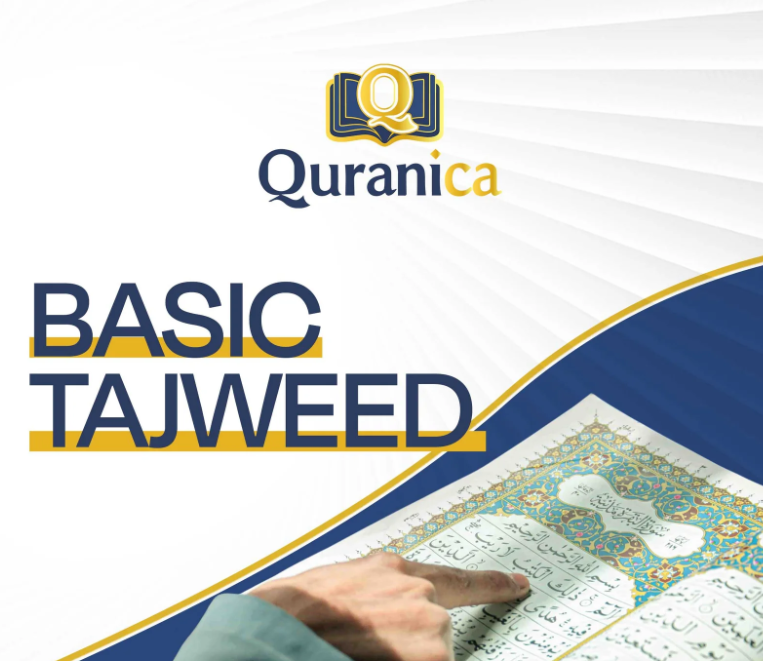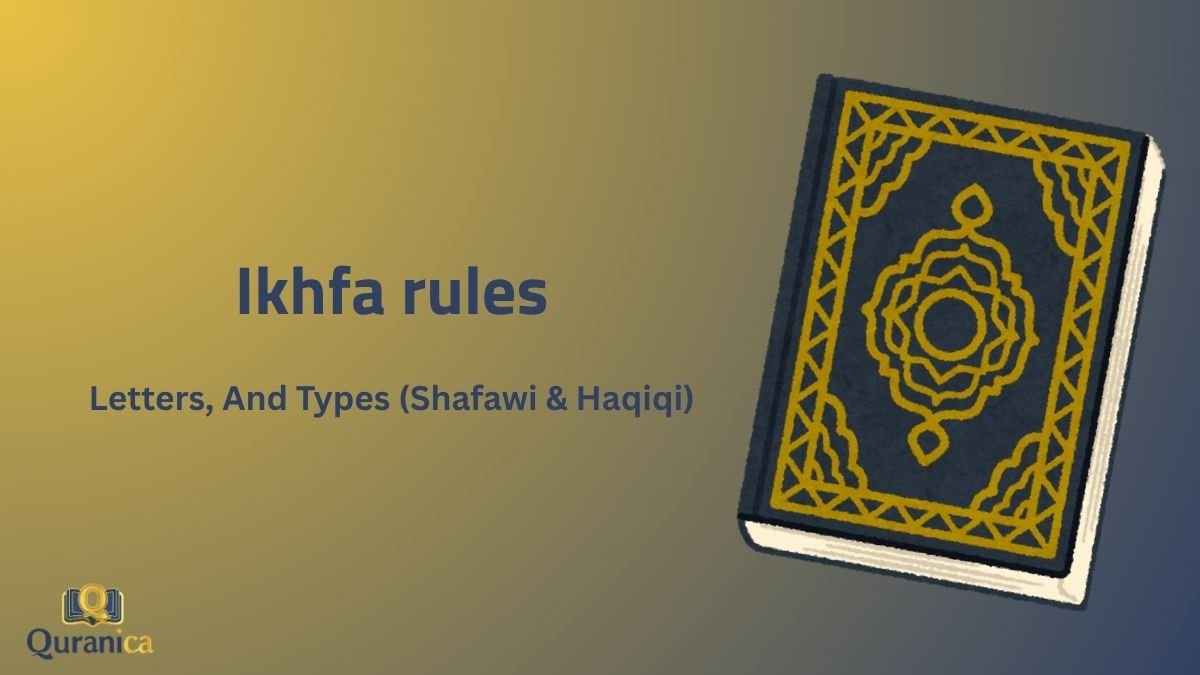In a nutshell: Ikhfa is a foundational Tajweed rule that governs how Noon Sakinah and Tanween are pronounced when followed by one of 15 specific letters, blending a hidden ‘n’ sound with a nasal Ghunna. It comes in two forms: Ikhfa Haqiqi for Noon and Tanween, and Ikhfa Shafawi for Meem Sakinah before Ba. The quality of Ghunna changes based on the following letter, requiring either a heavy or light tone.
The beauty of reciting the Quran lies not just in the melody of the voice, but in the precision of each sound.
Subtle rules like Ikhfa are the key to appreciating this beauty and deepening our connection with the Divine message.
This guide is designed to be your companion in mastering the Tajweed rule of Ikhfa. We will walk through it together, from its simplest meaning to its practical application, in a way that is clear and easy to follow.
What is Ikhfa?
Ikhfa is a central Tajweed rule that governs the pronunciation of the Noon Sakinah (نْ) and Tanween when they are followed by specific letters.
Ikhfa creates a unique, melodious sound that flows gently between clarifying the ‘n’ sound and completely merging it.
1. What is the Meaning of Ikhfa in Arabic
In the Arabic language, the word “Ikhfa” (إخفاء) literally means “to hide” or “to conceal.” Imagine you are hiding something, but not completely.
You’ve placed it behind a curtain, so its presence is softened and partially obscured. This is the essence of Ikhfa – we are “hiding” the clear sound of the Noon.
2. The Meaning of Ikhfa in Tajweed
In the science of Tajweed, Ikhfa is the specific manner of pronouncing a Noon Sakinah or a Tanween.
Ikhfa is a state that is between Izhar (absolute clarity) and Idgham (merging). This pronunciation is always accompanied by a Ghunna (a nasal sound) and occurs when the Noon Sakinah or Tanween is followed by one of the 15 designated Ikhfa letters.
So, how do we physically produce this “hidden” sound?
How Is Ikhfa Articulated?
When pronouncing Ikhfa, your tongue does not make firm contact with the articulation point (makhraj) of the Noon letter (the upper gum line behind your front teeth).
Instead, the tongue hovers close to the articulation point of the next letter in the word. This preparation for the upcoming letter is what “hides” the full Noon sound, allowing a gentle Ghunna to flow from the nasal passage for about two counts.
Types of Ikhfaa
To understand Ikhfa fully, we can organize it into two main categories. This helps to separate the rules based on the letter they apply to.
The two types are Ikhfa Haqiqi (the true or real Ikhfa) and Ikhfa Shafawi (the lip-based Ikhfa).
A. Ikhfa Haqiqi
The most common type of Ikhfa you will encounter is Ikhfa Haqiqi. This is the “true” or “real” Ikhfa, the one that applies to the Noon Sakinah and Tanween.
1. What Are the 15 Letters of Ikhfa Haqiqi?
There are 15 letters in the Arabic alphabet that trigger the rule of Ikhfa Haqiqi when they follow a Noon Sakinah or Tanween. They are:
(ت, ث, ج, د, ذ, ز, س, ش, ص, ض, ط, ظ, ف, ق, ك)
(Ta, Tha, Jeem, Dal, Dhal, Za, Seen, Sheen, Sad, Dad, Ta, Dha, Fa, Qaf, Kaf)
2. How to Learn Ikhfa Letters?
Fifteen letters can seem like a lot to memorize, but the scholars of Tajweed have made it easy for us. They collected these letters in a beautiful line of Arabic poetry.
The first letter of each word in this line is one of the letters of Ikhfa.
The line is:
صِفْ ذَا ثَنَا كَمْ جَادَ شَخْصٌ قَدْ سَمَا… دُمْ طَيِّبًا زِدْ فِي تُقًى ضَعْ ظَالِمًا
“Ṣif dhā thanā kam jāda shakhṣun qad samā… dum ṭayyiban zid fī tuqan ḍaʿ ẓāliman.”
Simply by memorizing this phrase, you have a mnemonic for all 15 letters! It’s a practical tool used by students of the Quran for centuries.
3. The Role of Ghunna (Nasalization) in Ikhfa
The Ghunna is the soul of Ikhfa. It is a continuous, gentle nasal sound that you hold for approximately two beats or counts.
Without this Ghunna, the Ikhfa is incomplete. The sound should emanate clearly from your nasal passage (al-khayshum), and you can feel a slight vibration there if you touch your nose while pronouncing it correctly.
You can perfect your pronunciation with guided, one-on-one feedback in Quranica’s Learn Tajweed for beginners Course.

Levels of Ikhfaa in Tajweed
The sound of Ikhfa is not always identical. It has different “ranks” or levels of intensity. This variation depends on how close the articulation point of the following letter is to the articulation point of the Noon.
1. Highest Level of Ikhfaa in Tajweed
This occurs with the letters ط (Taa), د (Daal), and ت (Taa). Their articulation point is very close to that of the Noon, so the Ikhfa is very strong.
2. Lowest Level of Ikhfaa in Tajweed
This is with the letters ق (Qaaf) and ك (Kaaf). Their articulation point is far back in the mouth, far from the Noon’s, resulting in a lighter Ikhfa.
3. Middle Level of Ikhfaa in Tajweed
This applies to the remaining ten letters, where the Ikhfa is balanced between the two extremes.
Tafkheem (Heaviness) and Tarqeeq (Lightness) in Ikhfaa
The ghunnah in Ikhfa adopts the quality of the following letter. This is a beautiful, subtle rule known as Tafkheem (heaviness) and Tarqeeq (lightness).
1. Heavy Ikhfa (Ikhfa with Tafkheem)
When the letter following the Noon Sakinah or Tanween is a “heavy” letter (a letter of Isti’laa), the Ghunna will also take on a heavy, full-mouthed quality. This is called Tafkheem. The five heavy letters of Ikhfa are:
(ص, ض, ط, ظ, ق)
Example of Heavy Ikhfa with Sad (ص):
“بِرِيحٍ صَرْصَرٍ”
Bireehin sarsarin
Here, the Ghunna on the Tanween is heavy because it is followed by the heavy letter Sad.
Example of Heavy Ikhfa with Qaf (ق):
“مِن قَبْلِ”
Min qabl
The Ghunna of the Noon is full-mouthed, preparing for the deep articulation of the Qaf.
3. Light Ikhfa (Ikhfa with Tarqeeq)
When the Ikhfa letter is one of the remaining ten “light” letters, the Ghunna will have a light, thin sound. This is called Tarqeeq. Your mouth should be in a more neutral or smiling position.
Example of Light Ikhfa with Ta (ت):
“جَنَّاتٍ تَجْرِي”
Jannaautin tajree
The Ghunna here is light and delicate as it leads into the light letter Ta.
Example of Light Ikhfa with Kaf (ك):
“مِن كُلِّ”
Min kullin
The Ghunna is light, matching the quality of the Kaf.
Mastering these subtle changes from a heavy to a light sound is a sign of a skilled reciter. We cover these nuances in great detail in Quranica’s Advanced Tajweed Course, helping you perfect every sound.

B. Ikhfa Shafawi is the Second Type of Ikhfa
Now we will discuss the second, more specific type of Ikhfa. This rule does not involve the Noon Sakinah or Tanween, but rather the Meem Sakinah (مْ).
1. Why does it called Shafawi?
It’s called “Shafawi” (شفوي), which means “labial” or “of the lips,” because both the Meem and the Ba are articulated using the lips.
2. The Rule of Ikhfa Shafawi
The rule of Ikhfa Shafawi is very simple. It occurs in only one situation:
If a Meem Sakinah (مْ) is followed by the letter Ba (ب).
When this happens, the Meem is recited with a light Ghunna.
3. How to Pronounce Ikhfa Shafawi
To pronounce it correctly, you close your lips gently to produce the Meem sound, but without pressing them together firmly as you would for a clear Meem.
From this gentle closure, you hold a 2-beat ghunnah before opening the lips to articulate the Baa. It is a soft, nasal transition between the two lip-based letters.
4. Ikhfa Shafawi Example From Quran
“تَرْمِيهِم بِحِجَارَةٍ”
Tarmeehim bihijaratin
“Striking them with stones of baked clay,”
Ikhfa Examples in Quran
Seeing the rules applied within the verses of the Quran is the best way to truly understand and internalize them.
Let’s explore some more specific examples together, so you can begin to recognize and pronounce Ikhfa confidently during your own recitation.
1. Ikhfa Noon Saakin Examples
Here we will look at how a Noon Sakinah (نْ), a noon with no vowel, is hidden when followed by an Ikhfa letter. Pay close attention to the light Ghunna sound that connects the Noon to the next letter.
Example of Ikhfa Noon Sakinah (نْ) followed by Tay (ت)
كُنتُمْ
kuntum
“You were.”
The Noon Sakinah is followed by the letter Ta (ت). Since the articulation point of Ta is very close to that of Noon, this is the highest level of Ikhfa, creating a very smooth transition with a light ghunnah.
Example of Ikhfa Noon Sakinah (نْ) followed by Qaf (ق)
يَنقَلِبُونَ
yanqaliboona
“They will return.”
The Noon in “yanqaliboona” is followed by the heavy letter Qaf (ق). This triggers Ikhfa with a corresponding heavy ghunnah, where the sound is hidden before articulating the Qaf from the back of the tongue.
2. Ikhfa Tanween Example
The same beautiful rule of hiding applies to Tanween, the double vowel markings that produce an “n” sound at the end of a word. The application of Ikhfa here ensures a smooth and flowing transition between words.
Example of Ikhfa Tanween Fath (ـً) followed by Kaf (ك)
“رِزْقًا كَرِيمًا”
Rizqan kareema
“…a noble provision.”
The Tght letter Kaf (ك). The Ikhfa is therefore pronounced with a lanween on رِزْقًا is followed by the liight, delicate Ghunna (Tarqeeq), making the connection between the two words seamless.
3. Ikhfa Meem Saakin Example
Finally, let’s revisit the special case of Ikhfa Shafawi, which involves the Meem Sakinah (مْ). This rule is exclusive to one letter combination, making it very easy to remember and apply. Meem Sakinah (مْ) followed by Ba (ب)
“فَبَشِّرْهُم بِعَذَابٍ”
Fabashirhum bi’adhabin
“…so give them tidings of a painful punishment.”
Observe the Meem Sakinah at the end of فَبَشِّرْهُم. When it meets the letter Ba (ب) in the next word, the lips close gently for the Meem, producing a light Ghunna before articulating the Ba.
Read also: Tanween In Quran And Tajweed With Examples and Symbol – Full Guide
How to Recognize Ikhfa in the Mushaf?
The beauty of the Uthmani script of the Quran is that it provides visual cues to help with Tajweed. You can spot Ikhfa just by looking at the page.
For Noon Sakinah: When Ikhfa is required, the Noon letter will be written without any diacritical mark (like a sukoon) on top of it (ن).
For Tanween: The markings for Tanween (two fathas, two kasras, or two dammas) will be slightly staggered or unaligned ( ً ٍ ٌ ). This is in contrast to Izhar, where they are perfectly aligned.
Common Mistakes Relating to Al-Ikhfaa Rule
By being aware of these frequent mistakes in applying Ikhfa, you can correct your recitation early and build a strong, accurate foundation.
1. Making the Ghunnah Too Long or Too Short
A balanced and beautiful recitation depends on giving each rule its proper timing. The Ghunnah of Ikhfa has a specific length that must be observed.
The Ghunnah should be held for approximately two counts—not rushed, and not overly prolonged.
A common error is to either cut it short, barely hiding the Noon, or to stretch it for three or four counts, which disrupts the rhythm of the verse.
2. Pronouncing a Clear ‘N’ Sound
This is perhaps the most frequent mistake made by beginners. Remember, the very meaning of Ikhfa is “to hide,” so the clear sound of the Noon must be concealed.
Students often touch their tongue firmly to the makhraj of the Noon (the upper gum line) out of habit, producing a clear “n” before initiating the Ghunnah.
The correct way is to go directly into the hidden Ghunnah sound without making that firm contact.
3. Neglecting the Heavy and Light Quality of the Ghunnah
A more subtle but crucial mistake is failing to differentiate between a heavy (Tafkheem) and light (Tarqeeq) Ghunnah. This distinction is what gives Ikhfa its eloquent and flowing character.
Reciting every Ikhfa with the same light sound, even before a heavy letter like Qaf (ق) or Ta’ (ط), removes a layer of beauty and precision from the recitation.
The Ghunnah must adopt the quality of the letter that follows it.
Master Ikhfa in Your Recitation with Quranica
Learning Tajweed is a journey of devotion, and mastering rules like Ikhfa brings you closer to reciting the Quran as it was revealed to our beloved Prophet Muhammad (peace be upon him).
At Quranica, we are dedicated to guiding you on this blessed path.
Why choose Quranica for your journey to learn Quran with Tajweed?
Expert Azhari Tutors
Learn from native Arab instructors who are graduates of the prestigious Al-Azhar University. They are not just teachers; they are certified with Ijazah to teach the Quran and have years of experience with non-Arabic speaking students.
Personalized Learning
We offer everything from our Learn Tajweed for Beginners course to an Advanced Tajweed Course, ensuring a perfect fit for your level. We also provide specialized classes like Online Tajweed Classes for Sisters and flexible Tajweed Classes for Adults.
Competitive & Accessible
We believe quality Islamic education should be available to everyone, offering top-tier instruction at competitive prices.
Whether you want to perfect your recitation, begin your Hifz journey with our Quran Hifz Classes, or achieve the highest level of mastery with an Online Ijazah Course, we are here for you.
We invite you to explore our world of authentic Quranic education:
- Learn Quran with Tajweed (for all levels)
- Quran Memorization (Hifz) Programs
- Ijazah Course
- Islamic Studies
- Ten Qirat
- Arabic Lessons for Beginners
Explore our full range of courses.
Join a Quranica course today!

Conclusion
Ikhfa is a key Tajweed rule that softens the sound of Noon Sakinah (نْ) or Tanween when followed by one of 15 specific letters, producing a nasalized sound called Ghunna.
Its name in Arabic means “to hide,” reflecting how the clear ‘n’ sound is subtly obscured in pronunciation.
There are two main types: Ikhfa Haqiqi, the standard rule applied to Noon and Tanween, and Ikhfa Shafawi, which applies when Meem Sakinah (مْ) is followed by the letter Ba (ب). Both involve gentle nasalization and require precise articulation.
Ikhfa varies in intensity—high, middle, or low—depending on the proximity of the following letter’s articulation point to that of the Noon. Ghunna also changes quality: it becomes heavy (Tafkheem) with strong letters and light (Tarqeeq) with soft ones.
Common errors include making the Ghunna too short or long, pronouncing a clear ‘n’ sound, and ignoring the heavy/light quality of letters. Quranica’s certified Azhari tutors offer tailored Tajweed courses to help students master these details with confidence.








0 Comments